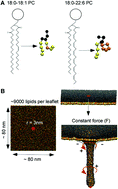The transbilayer distribution of polyunsaturated phospholipids determines their facilitating effect on membrane deformation†
Abstract
In the cell, membrane deformation and fission (collectively referred to as ‘budding’) is driven by specific protein machineries but is also influenced by lipid composition. We previously reported that phospholipids with polyunsaturated acyl chains facilitate membrane budding because they adapt their shape to membrane curvature, thereby decreasing membrane bending rigidity. The facilitating effect of polyunsaturated lipids was observed in experiments and simulations performed on membranes where the two bilayer leaflets had the same lipid composition. However, biological membranes are generally asymmetric. Here, we present coarse-grained molecular dynamics simulations on asymmetric phospholipid bilayers undergoing deformation via a pulling force along the bilayer normal. One leaflet contains monounsaturated C18:0-C18:1-phospholipids, whereas the opposite leaflet contains polyunsaturated C18:0-C22:6-phospholipids. When present in the monolayer orientated towards the pulling force and thereby in the convex face of the forming tube, C18:0-C22:6-phospholipids facilitate membrane tubulation. In contrast, C18:0-C22:6-phospholipids in the concave face of the tube have no effect. Analysis of lipid shape indicates that these contrasting effects arise from the superior ability of polyunsaturated phospholipids to swell in the convex leaflet, whereas mono and polyunsaturated phospholipids behave similarly in the concave leaflet. The leaflet-dependent effect of polyunsaturated phospholipids matches well their asymmetric distribution in biological membranes, notably in synaptic vesicles, which are produced by the fastest budding event in the body.

- This article is part of the themed collection: Remodelling of Biomembranes


 Please wait while we load your content...
Please wait while we load your content...